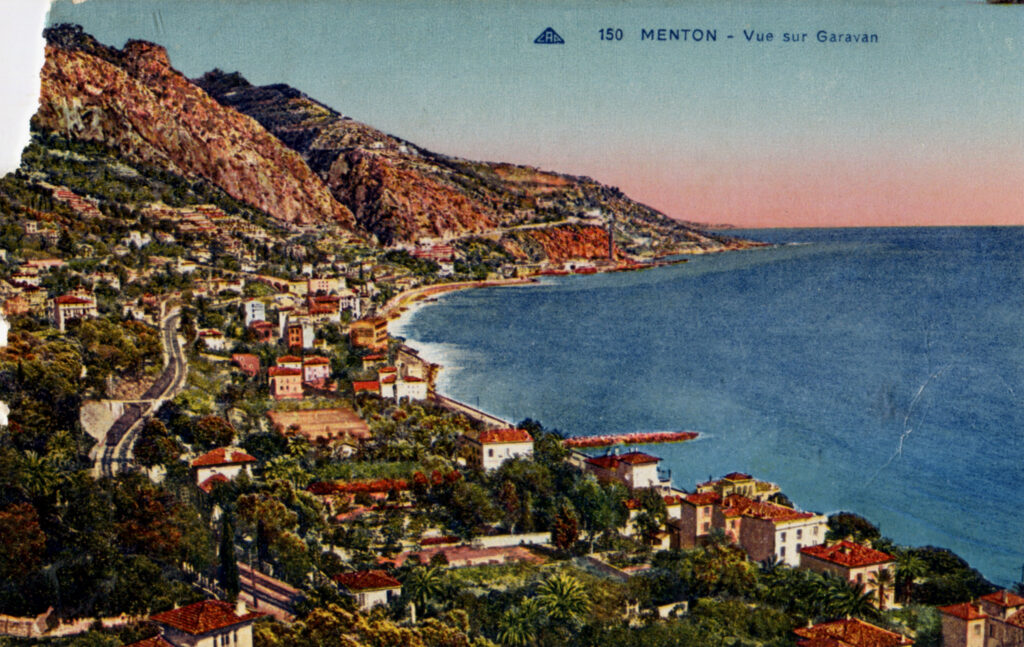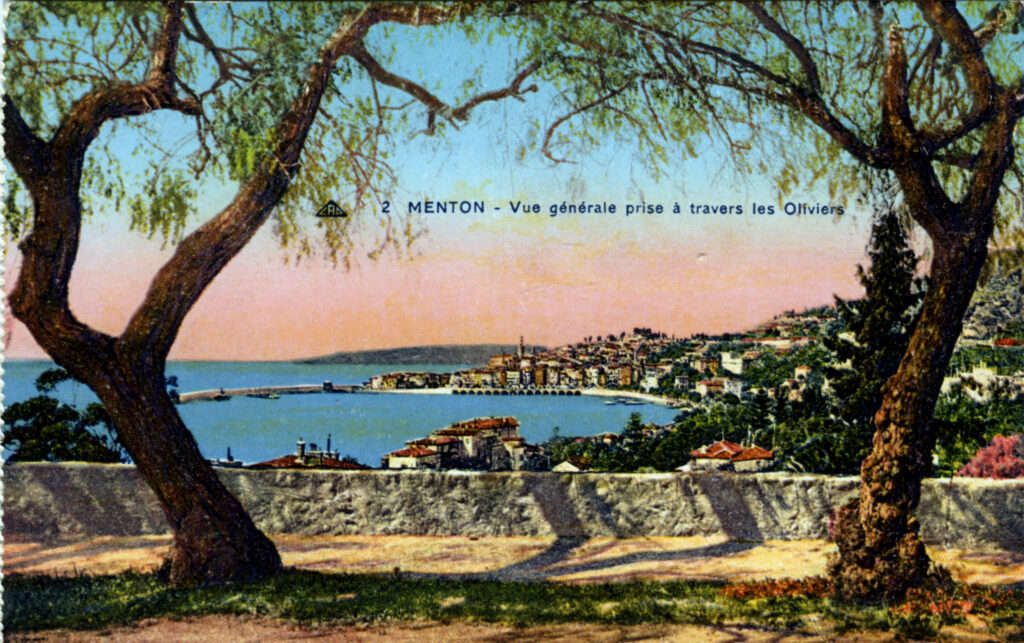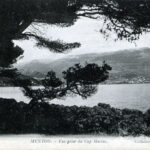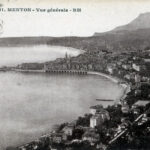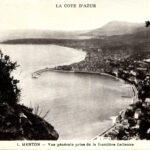Menton is one of the most beautiful places on the Côte d’Azur. Lemon groves, beautiful harbor. Depicted on old photo postcards of the early 20th century.
Menton history briefly
Menton is a resort city and a commune of the same name in the Nice district of the Alpes-Maritimes department of the Provence-Alpes-Côte d’Azur region.
The area of Menton has been inhabited since the Paleolithic period, the remains of Neanderthals and Cro-Magnons were found here.
In the Roman era, the Via Julia Augusta, the road connecting Placentia (Piacenza) with Arelates (now Arles), passed through Menton along Rue Longuet in the Old Town. The French geographer Ernest Negro pointed out that the name Menton comes from the Roman name Mento. However, it is possible that the name of the city comes from Mons Ottonis – the name of Otto II, Count of Ventimiglia (1162 – 1200). In the 11th century Count Ventimiglia built Puiping Castle on Pepin Hill northwest of the modern city center. In the 13th century The lordship of Puiping passed into the possession of the Vento family from Genoa, who built a new castle near the Roman road (now located on the site of the cemetery of the Old Castle), thus forming the core around which the current city grew. Then Menton became part of the Republic of Genoa.
The first mention of the city is found on July 21, 1262 in a peace treaty between Charles of Anjou and Genoa. Its location is mentioned between Provence, which ruled the Anjou dynasty, and the Republic of Genoa, which at that time claimed Monaco as its western border. In 1346, Menton was acquired by Charles Grimaldi, ruler of Monaco, and was ruled by the princes of Monaco until the French Revolution of 1789. During it, Menton was annexed by France and remained so during the First Empire. It belonged to the San Remo region in the Alpes-Maritimes department, which at that time included Monaco and San Remo. In 1814, Menton became part of the restored Principality of Monaco, which after the “100 days of Napoleon” became a protectorate under the control of the King of Sardinia. In 1848, Menton, together with its neighbor Roquebrune, seceded from Monaco due to the increased export of lemons. During the revolutions of 1848, Menton proclaimed itself a “free city”. Two years later, Menton and Roquebrune gave themselves under the rule of the Sardinian kingdom and for 10 years they were ruled by the Savoy dynasty.
The Treaty of Turin, signed on March 24, 1860 between the Kingdom of Sardinia and the French Empire of Napoleon III, stated the accession of the County of Nice (which included the city of Menton) to France as a gift from the latter for help in the war against Austria. Following the results of the plebiscite on March 15 and 16, 1860, by an overwhelming majority of votes (833 against 54 in Menton and Roquebrune), Menton with its surroundings was ceded to France. It is interesting to note that among the opponents of this was the famous Italian nationalist Giuseppe Garibaldi. In June of the same year, Nice was annexed to France and Napoleon III paid the Prince of Monaco, who renounced his rights on February 2, 1861, 4 million francs.
The publication of the book of the English physician J. G. Bennett “Winter and Summer on the Shores of the Mediterranean” (1861) had a very strong impact on Menton, turning it into a popular place for the treatment of tuberculosis.
By the end of the century it had become a famous holiday destination for the European (mainly British and Russian) aristocracy, who built many luxurious hotels, villas and palaces here.
During the First World War, many of these buildings served as hospitals for wounded soldiers.
During World War II, in June 1940, Italy invaded France, occupying part of it. Following the armistice on June 22 of that year, two-thirds of the territory of the commune of Menton was annexed by Italy as “unredeemed land”. Despite the fact that Menton officially returned to Vichy France, it was actually occupied by Germany until it was liberated by the British and Canadian units of the 1st Special Service Detachment on September 7 (or 8), 1944. In the post-war period, the thoroughly damaged city was restored and many its buildings have been reconstructed. Menton is the first city on the Riviera to receive the honorary title of “City of Art and History”. The city confidently holds the glory of one of the most luxurious resorts in Europe.
Photo gallery of old and modern views of the city of Menton and surroundings.
- View of the city from the cape
- Panoramic views of the bay and beaches
- One more photo from the Italy border
Main Attractions to see in Menton
For domestic tourists, the following main attractions are probably of greatest interest:
– The old city, with its streets, squares and markets
– Russian cemetery “Old Castle”
– Chapel of the Icon of the Mother of God and “Joy of All Who Sorrow”
– Church of the Blessed Virgin and Nicholas the Wonderworker
– Cathedral of St. Archangel Michael (1619)
– a bastion in the port of Menton, built on the high seas by the princes of Monaco and now part of the Jean Cocteau Museum;
– City Hall building, whose wedding hall in the 1950s. was decorated with paintings by Jean Cocteau (1889 – 1963)
In addition, the Fontana Rosa, Maria Serena, Serre de Madone, Palais Cornoles, Val Rahmeh gardens make a great impression.
In the 15th century In Menton, they began to grow lemons, and every year in late February – early March, lemon festivals are held here with a festive procession and the creation of compositions from citrus fruits.
Crowned persons began to come to Menton as early as the 19th century: Queen Victoria of Great Britain, Empress Eugenie of France, King Albert I of Belgium. Composers Franz Liszt, Charles Gounod, writers Guy de Maupassant and Katherine Mansfield also visited Menton.
Culture and art
It is also worth visiting the Jean Cocteau Museum – an artist, writer, poet, playwright and film director. It was opened in November 2011. The initiator of this event was an American of Belgian origin, Severin Wunderman, who collected paintings from the age of 18 and donated 1,800 works to the museum. More than half of the works collected here are by Cocteau, the rest are paintings by P. Picasso, A. Modigliani and other authors.
The Museum of Fine Arts is located in the summer residence of the princes of Grimaldi – the Carnole Palace. It contains paintings by contemporary artists and paintings from the 13th – 20th centuries. Entrance to it is free.
The Church of St. Archangel Michael began to be built in 1640. In 1999, Pope John Paul II declared it a basilica. Every year in August, the Menton Music Festival is held at the entrance to the Basilica. In its courtyard, you can see the mosaic coat of arms of Grimaldi.
At the end of the 19th century in Menton were built a casino and two magnificent palaces – hotels – “Royal Westminster” and “Ambassador”.
Transport how to get there
The airport. The most convenient is Nice. Flights from Paris (Charles de Gaulle, Beauvais and Orly) and other cities in France and worldwide.
Railway. High speed trains. local lines.
- Cote d’Azur sightseeing tours from Nice and Cannes with private guide
You can also see the city during a sightseeing private tour from Nice (Cannes) to Italy, just tell the guide about it to adjust the trip program.

